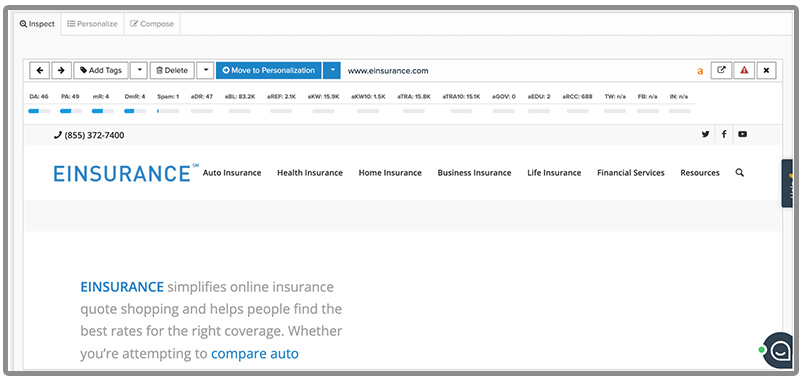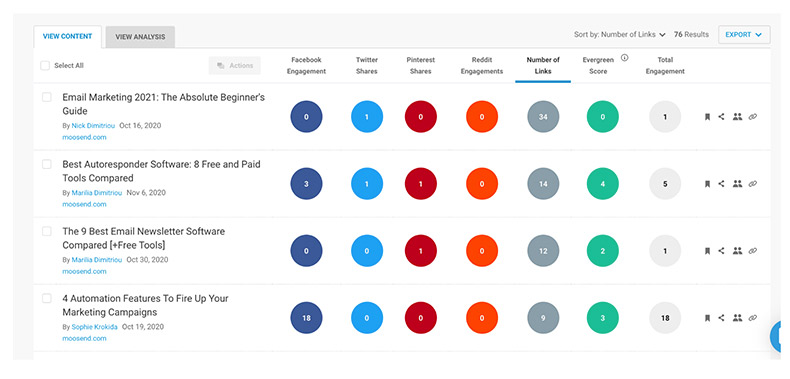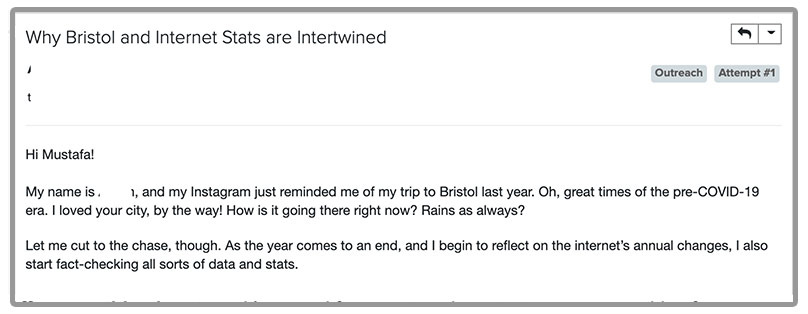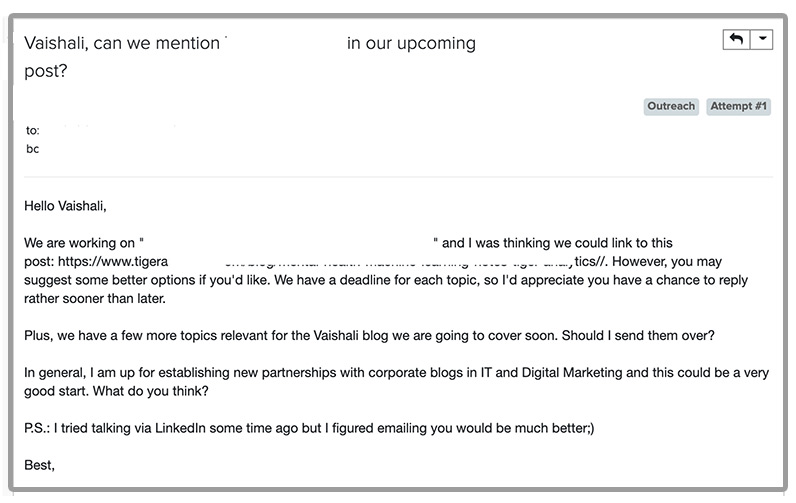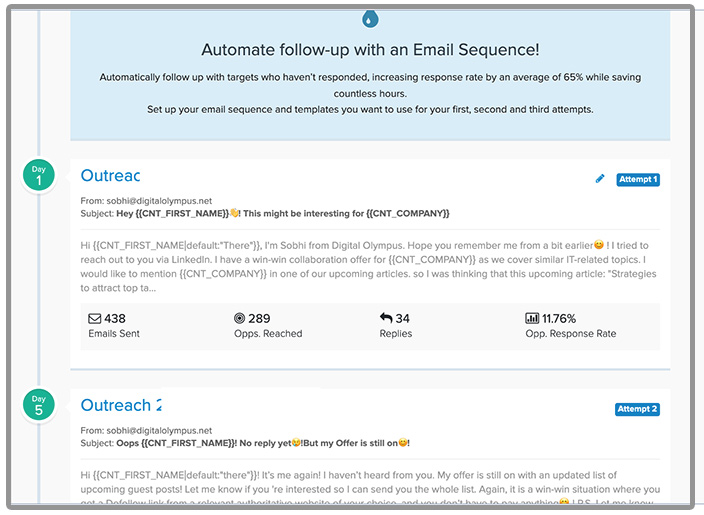Email Outreach Strategy (How to Improve Your Response and Win Rates)

“My email outreach sucks; I get absolutely no replies.”
I often get similar messages from outreach novices, and I want to say that I feel your pain. It takes a while for the results to come around, and most outreach opportunities don’t bring any partnerships until you form a relationship with a prospect.
If you can relate to this problem, let me share with you a few lessons I’ve learned throughout my experience on how to approach a prospect and actually get them interested in replying. Here is what we’ll be talking about:
- How to find relevant outreach opportunities.
- How to do personalization the right way.
- What it takes to put together a winning follow-up.
Let’s dive in.
Link Prospecting Warning: Target Relevant Opportunities Only
With link prospecting, quality always goes before quantity. You can build the most extensive list of prospects, but it doesn’t guarantee an outstanding and immediate result.
The same goes for the relevance of your prospects – if an outreach contact comes from an industry or niche completely unrelated to yours, don’t expect them to be interested in replying. In other words, garbage in, garbage out. If you add irrelevant sites, you’ll get a response rate close to zero.
That’s why I always recommend initiating the outreach process by double-checking if the site is relevant to your niche. Usually, you have to do it manually, but tools like Pitchbox can make your life easier. There, you can click through websites without opening each of them in a new tab:
Apart from checking the relevance on the niche and industry level, It’s also of utmost importance to have a closer look at the prospect’s website and answer the following questions:
- Does a website have the right content to place your links in?
- Is the blog updated regularly?
- Is there content on the website that its owners are trying to promote and get it to rank higher in SERPs?
Let me clarify all three points.
First and foremost, if a website doesn’t have blog posts that fit the requirements of your link-building campaign, don’t bet on it. There is hardly any chance to get a backlink from it.
Blog activity also matters a lot. Sometimes, you will find that the website owners have abandoned the blog and clearly don’t invest in content marketing and SEO. Or, on the contrary, the website can look promising, but it’s clear that other priorities are more important than blog content. Either way, you don’t want to waste your time if it’s obvious that no one will respond.
Finally, if a website is doing a promotional campaign for one of its content pieces and is actively building links to it, you can also use this opportunity to make your pitch. To find this information, check the BuzzSumo Web Content report – it allows you to see which posts have gained the biggest number of referring domains:
Pro tip: Consider taking advantage of the connections you already have across various channels. For instance, you can start a poll on LinkedIn asking questions related to link building. It’s not only a way to increase profile activity but also enrich your list of outreach contacts. The thing is that on LinkedIn, you can see the names of poll participants. Sneaky but creative.
You can pull the same trick with polls on Facebook. The only thing is that you need to become a member of a niche-relevant Facebook group first. If you don’t know where to start, you can join the B2B Bloggers Boost group. There, you’ll find many valuable connections.
Never Disregard Personalization
Think about personalization as the holy grail of email outreach – you should persistently seek after it. The reason is the key to successful link outreach is relationship building. It controls the response and win rates of your outreach campaign. Surely, personalization takes a lot of research and effort. But the end result will surprise you.
Let me tell you about a little experiment my team and I conducted some time ago. We’ve created two outreach mail-outs – one followed a template, and the other consisted of highly personalized messages.
The results were astounding but expected: the template mail-out only got one or two replies per hundred messages, while the personalized messages got twice as many positive responses.
On that note, you should understand that personalization goes far beyond adding the addressee’s name. Rather, calling a prospect by their name is more of a given.
Here’s what I recommend doing to make your emails more personalized:
- Choose the right people for outreach. As I mentioned earlier, it should be an outreach contact with a relevant job position. For instance, it could be someone working in an SEO or PR department.
- Refer to the prospect’s online activity. For example, you can go through a prospect’s LinkedIn feed (given that they are active there), pick an interesting post, and refer to it in your email. It will help your message stand out.
- Let your creativity flow. Is there an interest that unites you with the prospect? Do you have shared experiences? If yes, by all means, mention it in your email. For instance, I found out that my prospect lived in Bristol and led my message with a related story to pitch some stats:
- Offer something in return. It’s natural for an outreach contact to want something from you. So, immediately look for organic ways to link back to their website or page. For instance, you can get them featured in a guest post, or your newsletter or mention them on social media if you have a solid presence there. Here, I’m offering a link back in the upcoming post:
Note that I’m talking about building partnerships with corporate blogs. It’s important to emphasize that the backlink will be coming only from highly trusted blogs owned by verified businesses and organizations. Such links have greater value for your position in SERPs.
Pro tip: Before sending an outreach email, try doing a warm-up on LinkedIn. Simply connect with the prospect, leave a short message indicating your intentions, or make a meaningful comment under one of their recent posts.
Milosz Krasinski:
“Always remember that, when receiving an email, the recipient’s first – and only – thought is going to be ‘what’s in it for me?’. Most people receive a huge number of emails every day; so your outreach needs to be laser-focused in terms of personalisation – with messaging that resonates with the recipient immediately and comprehensively”.
Follow Up on Your Outreach Emails Religiously
A follow-up is not a choice but rather an inalienable part of an email outreach campaign. A common mistake is to consider an outreach contact lost if they don’t reply after the first email.
In fact, there’s also research confirming the necessity of follow-ups. Reportedly, 80% of non-routine deals get closed after at least five follow-up messages, and only 2% happen after the first encounter with the prospect.
Although this research focused on sales, we can still draw some lessons for email outreach – no matter how creative your pitch is, a follow-up is always a must. So, start thinking about it in advance.
Here are a few pieces of advice I can share with you regarding a winning follow-up:
- No boring stuff is allowed. What do I mean by boring? Phrases similar to “I’ve never heard from you,” “Maybe you forgot to reply,” or something similar to this email:
- Follow up on your original story. If you led your first message with a joke or some other narrative similar to my example in the previous section, start your new message by giving more details on it or at least come up with something related.
- Don’t be too pushy. You might be anxious to get a reply, but being overly persistent can do more harm than good. Don’t follow up too much and too frequently. From my experience, I’d recommend sending no more than three follow-ups.
If you’re getting zero replies, consider checking if you’re targeting the right person. The reason might be behind targeting the wrong connection.
Pro tip: You can always automate your follow-up game with specific tools. Take Pitchbox, for example. You can use it to schedule all follow-up emails right away and make them highly personalized by adding prospect-specific details. For instance, you can congratulate your outreach contact on a recently acquired link from a high-quality resource.
There’s also a cool feature called ‘Merge Fields’ that allows you to automatically add information in the subject line and body of your email.
Over to You
Email outreach is an excellent strategy for finding winning partnerships, but it’s common to have low response and win rates if you don’t put in some extra effort.
Firstly, I’m talking about the quality of the prospects for outreach. Are they relevant to your business? Do they have proper content where they can fit your link? Is their blog active? Do some digging before catching up with them.
Secondly, work hard on personalizing your messages. Research the person for the outreach thoroughly, explore their social media activity, and think of a valuable offer in return. In other words, find something that will make this particular person interested in replying.
Finally, treat your follow-ups as seriously as your pitches. Maintain the same train of thought and be consistent. This is my working recipe for better response and win rates. What are your ideas? What else would you recommend for a more fruitful email outreach campaign?
Your full marketing toolkit for a winning strategy
The ultimate solution to help you build the best digital strategy
